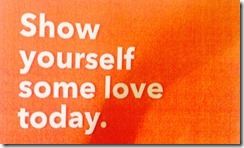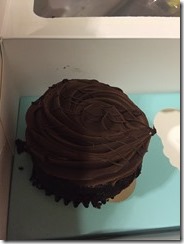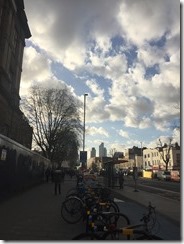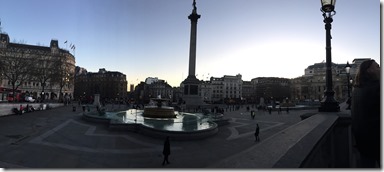I started this blog on the very first day of 2015—and 2015 has been quite a year. In a semi-cliché way, it has been my best year so far—not because it was perfect or because all the things I planned on happening happened or because I didn’t fail at all the lofty resolutions I made—but because things were messy at times, because unplanned, unexpected moments happened, because I dropped my lofty resolutions in pursuit of tangible goals—moving away from aspirations to change myself and towards accepting myself.
One year ago today, I sat in a Subway in upstate New York when all the tables at a nearby Starbucks was full, typed out some thoughts, hit the backspace button, typed out more thoughts, hit the backspace button again, and repeated this for about an hour.
For women—or anyone whose identity marginalizes them—it can be challenging to allow yourself to take up space, to have valid thoughts and opinions, and to feel as if these thoughts and opinions are worth openly expressing. For a while, before I would start writing a post, I would have to shut down internal thoughts that what I’m saying doesn’t matter, that it’s unnecessary. Even though these thoughts still crop up every now and again, blogging has really helped me turn them off.
In 2016, I’m urging any of you out there with an idea for a project that you’re too afraid to start because you think it’s not important—go ahead and do it anyways. You don’t know what will come of it until you give it a shot.
I had no idea what was going to come out of that first post—a stipend to complete an internship with a progressive media outlet in Washington, D.C., which led to a summer position blogging for Young People For as their Civic Engagement Intern, starting their blog team, and joining their fellowship class. Through blogging and Young People For, I’ve been connected to a wonderful and supportive community of activists that I can lean on whenever I need a friend.
In 2016, don’t just set goals trying to fix things about yourself, create something. Do something with your hands, think critically, and use your body meaningfully instead of focus on the way it looks, its flaws, and what can be done to change it. Treat your body like a tool that can help you accomplish things.
On that note, in 2015 I made great strides towards loving my body and developing a sense of body positivity—something I’ve really struggled with in the past. I’m not saying that all is perfect now and that there aren’t still billion dollar media, fashion, and beauty industries in place propagating the idea that I should hate myself, but I’ve realized that self-love is critical and revolutionary and helps shut these industries down.
When I sat in that Subway to write my first post, I listened to two teenagers nearby talk about how much they hate their stomachs. It was what motivated me to stop backspacing and keep typing because we need to keep having these conversations, we need to be thinking about what still needs to change.
If I think back to my 13, 14, 15, or even 19-year-old self, I realize that I used to be (and at times still am) like those teenage girls at Subway. When degrading your body and degrading yourself for eating food is considered normal, it can be difficult to realize why we do these things and to even notice when you’re doing them.
In 2015, I started running in the daylight. I used to always run only in the dark because I didn’t want the people I passed to see my body, to see me sweating and breathing heavily—because that doesn’t happen naturally when we run, does it? It wasn’t until I lived in Washington, DC and was faced with the choice of giving up doing something I loved or running during the day in front of people that I finally stopped caring so much. Running became a tool for me to connect with my body, to use it for something, to learn how to like it.
I also started running in a sports bra. This may seem insignificant but it matters to the part of me that used to wear t-shirts on the beach and struggle in the dining hall every day over whether or not to eat fries or salad with no dressing. Exposing my stomach, unapologetically, amidst all these messages that my body is ugly and that I should change it, is a big deal.
In 2016, if learning how to love your body is too difficult, work on finding other ways to connect with your body. It doesn’t have to be anything physical like running, it can be painting, writing, going outside, or having fulfilling conversations. Find what works for you.
Another one of my favorite parts of 2015 was my internship in the Education Department at The Advocacy Center, a local sexual assault resource center, where I created resources for student activists and helped facilitate programs on healthy relationships and bystander intervention. Working there helped me recover from a bad part of my own life and taught me what I deserve in relationships and what steps we can take as a community to eradicate gender-based violence.
In 2016, don’t be afraid to demand more from the people in your life and set higher standards for how you deserve to be treated.
The theme for my 2016 is to be unapologetic. To let myself take up space and be unapologetic when it comes to the food I eat, clothes I wear, the skin I choose to show, the expectations I have for my relationships, and speaking my mind. To keep writing, learning, and thinking critically. To read more books and spend less time scrolling aimlessly through social media. To demand more from the people in my life, but to also learn how to forgive and heal and move on from hurt. To create more content, more blog posts, to express my thoughts unapologetically.
I think I’ll end my first post of 2016 there. Thanks for supporting and reading. I’m looking forward to what’s coming this year. Following my own first tip, I have a new project on the way in the coming months. I’ll keep it a surprise for now.
All the best,
Christina





